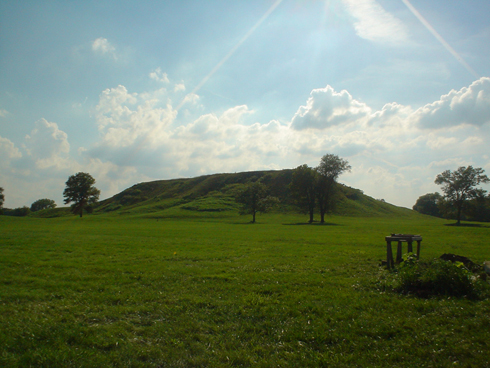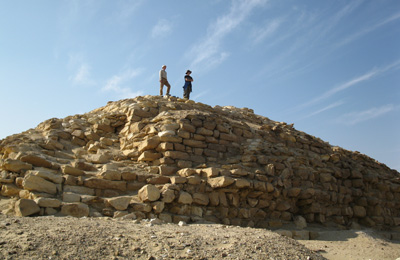 Its that time of the year again. School is almost out, archaeological field seasons are about to begin and what comes in between? Huge conferences of course! Over the next month there will be three major archaeological conferences taking place in Canada and the US. The American Research Center in Egypt (ARCE) will hold their 61st annual meeting this month in California, and the Canadian Archaeological Association’s 2010 conference will round off the month in Alberta.
Its that time of the year again. School is almost out, archaeological field seasons are about to begin and what comes in between? Huge conferences of course! Over the next month there will be three major archaeological conferences taking place in Canada and the US. The American Research Center in Egypt (ARCE) will hold their 61st annual meeting this month in California, and the Canadian Archaeological Association’s 2010 conference will round off the month in Alberta.
The first, and biggest, conference is the Society for American Archaeology (SAA) 75th Anniversary meeting in St. Louis Missouri from April 14-18. More than 3,000 archaeologists from around the world will be packing the America Centre and the St. Louis Grand Hotel for the event. I spent a portion of the Easter Break reading over the research abstracts and can certainly say that the conference offers a wealth of new research. Its difficult to pull out highlights so to speak but Ill touch on a few things.
Polynesians in South America
Polynesia is always a hot topic in archaeology and this conference will be no exception. There are a string of papers that will discuss evidence for contact between Polynesians and the ancient people of South America.
A few years ago a team of researchers presented DNA evidence suggesting that Polynesian chickens wereinNew Worldbefore theEuropean variety. That evidence has not been universally accepted. At this conference archaeologists are hoping to put this debate to rest.
(We) will discuss the evidence from physical anthropology, including both anthropometric and genetic data that may provide conclusive evidence of Polynesian presence in South America and help assess the nature of that contact wrote archaeologists Lisa Matisoo-Smith and Jose-Miguel Ramirez in an abstract.
Thats not all; linguistic evidence of Polynesian/South American contact will also be presented.
 Since identification four years ago of three words in two southern California Native languages that suggest prehistoric contact with Polynesia, additional information has started to accumulate from both North and South America writes Kathryn Klar.
Since identification four years ago of three words in two southern California Native languages that suggest prehistoric contact with Polynesia, additional information has started to accumulate from both North and South America writes Kathryn Klar.
Klar will present three new linguistic findings:
(1) a word for “sewn-plank canoe” from the western Patagonian language, Alakaluf; (2) an intriguing set of words for “harpoon” or “spear point” from around the southern Pacific basin (North and South America, and Polynesia); (3) the Quechua word walpa (meaning chicken). The latter is especially important in light of the recent identification of pre-Columbian Polynesian chicken remains in South America.
A side note Heritage Key broke news a few months back that archaeologists have found evidence that coastal South American groups voyaged to the Galapagos Islands before Columbus. No evidence of Polynesians has been found on those islands so far.
Palace Discovery in China
Archaeologists Zhichuan Jing and Jigen Tang are investigating what they say is the largest palace/temple compound ever discovered in Bronze Age China. It dates to the 13th century BC and was found in Huanbei City, a walled urban center in Anyang.
The Shang Period (ca. 1600-1050 BC) is an interesting time-period in Chinese history. The first Chinese writing that we know about (inscriptions on oracle bones) dates to this period. The Shang is also the first Chinese dynasty that archaeologists can say actually existed. There are stories in Chinese lore about a Xia dynasty that precedes the Shang, but researchers cannot prove that it existed.
New Discoveries at Tell Tsaf
Archaeologist Yosef Garfinkel will be presenting the latest research from the site of Tell Tsaf in Israel. This settlement dates back nearly 7,000 years, to the time of the Neolithic. Previous archaeological work has uncovered sizable structures identified as granaries. Garfinkel will be discussing the latest finds.
The accumulation of wealth is indicated by large dwellings, elaborate pottery and exported exotic items from Anatolian, Mesopotamia and Egypt. In addition (about) 140 clay sealings and a stone seal were found, indicating an administration system which was practiced at Tel Tsaf he writes.
What Im wondering is could Tel Tsaf be more of a city than a village? If thats the case well have to re-write the history books. The earliest urban centres are believed to be located in Mesopotamia and Syria, dating back some 5,000 to 6,000 years. Hamoukar is one example of an early city that archaeologists will be returning to this summer.
New Research on Cahokia Rituals

This conference promises to shed new light on the ancient city of Cahokia. It waslocated near modern day St. Louis and is estimated to have at least 100 mounds, and cover an area larger than medieval London! It reached its peak from roughly 1050-1200 AD.
Mound 34 is the topic of several papers. First excavated in the 1950s, Mound 34 had copper workshops nearby and seems to have been a centre of ritual activity. Archaeologists Lori Belknap, James Brown and John Kelly will be presenting new research that will show that Mound 34 is an exceptional place on the cultural landscape (of Cahokia) of AD 1200.
Cahokia, Polynesia, Shang China and the Neolithic Near East are not even the tip of the iceberg as far as this conference is concerned. There are several hundred papers being presented so there will be something for everyone.
ARCE Annual Meeting

This month will also be a good month for Egypt lovers. The American Research Center in Egypt (ARCE) is holding their 61st annual meeting from April 23-25 at the Oakland Marriot City Center in Oakland, California.
The abstract book is being printed and mailed out as Im writing this so we should know details about the papers in another week or two.
Right nowI can say that there willbenearly 100 papersgiven at the conference. There will be numerous research results presented including work at the Senwosret III Pyramid at Dashur, Tell Edfu, the Seila and Meidum pyramids and Pacific Lutheran Universitys work at the Valley of the Kings just to name a few!
Heritage Key has written stories on a number of the research projects that will be discussed at the conference. These include the Amarna fortress at Tell el-Borg in the Sinai Desert, the discovery of a massive statue of Taharqa, deep in Sudan, and new work done at the Seila Pyramid.
Canadian Archaeological Association Conference
Last but not least is the Canadian Archaeological Association’s 2010 conference which is set for April 28-May 2. It takes place in Calgary, Alberta. Featuring over 100 papers the conference focuses on the archaeology of Canada, with a particularly generous helping of research from Western Canada. One abstract I found interesting is that of a burial in Big Trout Lake.
Big Trout is quite an interesting place. To say thatit is a remote part of Canada is an understatement. Its located near the Manitoba border in Ontario’s Far North region. This region is about the size of the entire UK andhas asub-arctic climate, full of mosquitoes. Today it has a population ofabout 24,000 people, most of whom have no access to Ontarios road or rail system. Theymust rely on helicopter or airplane to get out.Trying toleaveon foot/canoe is a perilous journey that involves traversing vast distances of wilderness. Archaeologists Scott Hamilton and David Finch say in their abstract that:
Excavation revealed a Late Woodland archaeological deposit overlying the adult male burial. Pottery recoveries suggest Blackduck cultural affiliation, perhaps its most northerly expression in northern Ontario to date. Its relationship to the underlying burial remains to be determined through radiocarbon dating.
If this burial is Late Woodland it means that it dates to before European contact,roughly 1000 AD, give or take a few hundred years. The Blackduck culture is usually found much further to the south, around the Ontario-Minnesota border.
Its interesting to thinkthat a personin ancient timescould get into this area on foot- modern day westerners need aircraft in order to do it safely. It also raises an interesting question – what was he doing so far north?
I’m hoping that these conferences will be able to answer a lot of questions. Stay tuned to this page for more info.